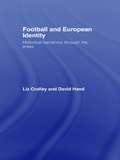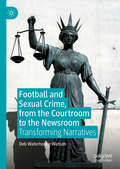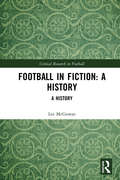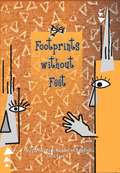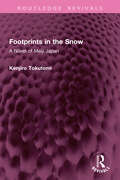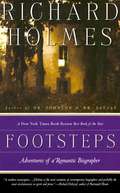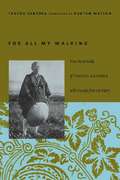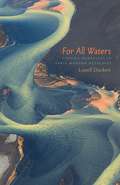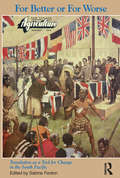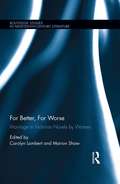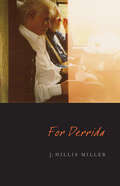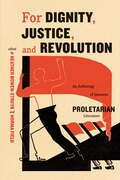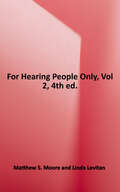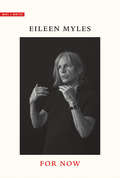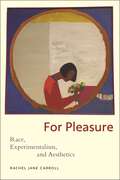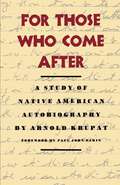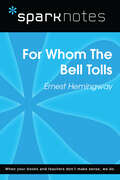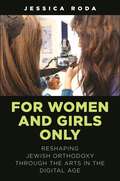- Table View
- List View
Football and European Identity: Historical Narratives Through the Press
by Liz Crolley David HandShifting European identities, cultural loyalties and divisions are often expressed more directly through attitudes to 'the people's game' game than in any other arena. This book examines European football journalism from throughout the last century to present a unique cross-cultural analysis of changing European national and regional identities. Building on detailed research into original language sources from across Western Europe, from the early 20th century to the present day, Football and European Identity traces this fascinating evolution. The resulting cross-cultural analysis of national identity in Europe provides the basis for a unique study of the interplay between football, society, politics and the print media, in three parts: Part 1: Old Europe national identity in the football writing of England, France, Germany, Italy and Spain Part 2: Nations within a State examines the status of Corsican, Catalonian and Basque identities Part 3: New (Football) Worlds explores the response of Europe’s presses to the emergence of Africa, South East Asia and the USA as major forces in world football
Football and Sexual Crime, from the Courtroom to the Newsroom: Transforming Narratives
by Deb Waterhouse-WatsonThis book interrogates the process of court reporting on rape and other sexual crime cases involving Australian footballers. At the intersection of sport, gender, media and the law, it uncovers the story behind rape myths and stereotypes in media. This book analyses newspaper reporting alongside transcripts of the trials they represent and interviews with the journalists themselves. Waterhouse-Watson’s work maps structural factors within newsrooms, and the complex relationship between the judiciary and media, that affect the practice of court reporting. This book approaches key journalism concepts like objectivity and balance critically, illustrating the layers of mediation that surround a complainant’s testimony; the way sport shapes the meaning of courtroom and media narratives in these cases; and the tension between racism and sexism when race is thematised or otherwise highlighted. Ultimately, the book proposes an ethics of court reporting that protects individual complainants, as well as advancing public understandings of the crime.
Football in Fiction: A History (Critical Research in Football)
by Lee McGowanFootball in Fiction represents the most comprehensive historical mapping and analysis of novels related to association football (soccer). It offers a theoretically informed field guide, a scholarly cartography of football fiction’s uncertain – and until now – only partially explored terrain. Combining an extensive search for texts with up-to-date academic research, journals, surveys, catalogues, and reviews the book demonstrates a topographic perspective of the field – one that captures and establishes its breadth, depth, and distinctive identity. The book uses and adapts two distinct reading models of abstraction, in conjunction with closer textual analyses. Together they assist in realising a set of demonstrable conventions, outline a taxonomy of fictive types, establish the genre’s current state of play, and advance the football novel as a form with its own literary history and traditions. This book is a valuable resource for those studying and researching in the areas of the social and cultural aspects of football, sports fiction, sports writing, creative writing, and literary and genre studies. Furthermore, related industry professionals will find this a fascinating read, particularly football writers, fans of the sport, and those interested in sports history and cultural phenomena.
Footprints Without Feet class 10 - NCERT
by National Council of Educational Research and TrainingThis book prescribed by central board of secondary education, India for the students of class 10th subject Supplementary English This accessible version of the book doesn't leave any part of the book. The book is handy companion of the school going students.
Footprints Without Feet class 10 - NCERT - 23
by National Council of Educational Research and Training"Footprints Without Feet" is a textbook for Class X by NCERT that offers a diverse collection of ten fascinating stories from various authors. These stories span multiple genres and touch upon intriguing themes, such as science fiction, human relationships, societal norms, and the mysteries of life and existence. From the tale of a man who becomes invisible in H.G. Wells' "Footprints Without Feet" to the story of a robot who begins to understand human emotions in "The Fun They Had" by Isaac Asimov, the book captivates its readers with unique perspectives on the human condition. Other stories touch upon issues of identity, moral dilemmas, and the effects of advanced technology on society. Through its rich narrative tapestry, the book encourages students to ponder on complex questions, enhancing their analytical and interpretative skills while providing a delightful reading experience.
Footprints in the Snow: A Novel of Meiji Japan (Routledge Revivals)
by Kenjiro TokutomiFirst published in 1901 and this English translation in 1970, Footprints in the Snow is one of the most popular novels in modern Japan. It is the story of the struggle of a penniless Japanese boy Shintaro Kikuchi, for education and emancipation. Determined to rebuild the family fortunes after his father's bankruptcy, Shintaro runs away from home in a remote corner of Kyushu, in the hope of making his way in the world. Robbed by pickpockets, he nearly dies of hunger and exhaustion, then after slaving for months as a money-lender’s boy eventually succeeds in reaching a Christian College in Kyoto. A brilliant student, he accepts Christianity enthusiastically, but is also repelled by the arrogance of the Western missionary teachers towards a Japanese colleague that he walks out in protest. At last, four years after leaving home, Shintaro arrives in Tokyo. Yet even in the city of his dreams his life is far from peaceful- Shintaro has to struggle to keep himself at University, to pursue his career as a writer and journalist and in order to marry the girl he loves.The original Japanese title of Footprints in the Snow is Omoide no Ki. Kenjiro Tokutomi ‘s novel is still read in Japan today and more than any other novel conveys what it felt like to be young in the days of Japan’s great transformation from feudal to modern state. This is an interesting read for students of Japanese literature, Asian literature, and literature in general
Footprints without Feet Supplementary Reader class 10 - JCERT
by Jharkhand Council of Educational Research and Training Ranchi“Footprints Without Feet” is a supplementary reader for Class 10 English. It consists of multiple stories that aim to develop students' reading and critical thinking skills. The stories, which range from personal relationships to adventures, reflect themes that resonate with young learners. One of the stories, “Footprints Without Feet,” is about a scientist who discovers how to make himself invisible and the consequences of his actions. The book encourages students to reflect on broader societal and ethical issues through thought-provoking questions, and its diverse content ensures an engaging learning experience.
Footsteps: Adventures of a Romantic Biographer
by Richard HolmesIn this gripping book, Holmes takes us from France's Massif Central, where he followed the route taken by Robert Louis Stevenson and a sweet-natured donkey, to Mary Wollstonecraft's Revolutionary Paris, to the Italian villages where Percy Shelly tried to cast off the structures of English morality and marriage.
For All My Walking: Free-Verse Haiku of Taneda Santoka
by Burton Watson Taneda SantokaIn April 1926, the Japanese poet Taneda Santoka (1882--1940) set off on the first of many walking trips, journeys in which he tramped thousands of miles through the Japanese countryside. These journeys were part of his religious training as a Buddhist monk as well as literary inspiration for his memorable and often painfully moving poems. The works he wrote during this time comprise a record of his quest for spiritual enlightenment. Although Santoka was master of conventional-style haiku, which he wrote in his youth, the vast majority of his works, and those for which he is most admired, are in free-verse form. He also left a number of diaries in which he frequently recorded the circumstances that had led to the composition of a particular poem or group of poems. In For All My Walking,master translator Burton Watson makes Santoka's life story and literary journeys available to English-speaking readers and students of haiku and Zen Buddhism. He allows us to meet Santoka directly, not by withholding his own opinions but by leaving room for us to form our own. Watson's translations bring across not only the poetry but also the emotional force at the core of the poems. This volume includes 245 of Santoka's poems and of excerpts from his prose diary, along with a chronology of his life and a compelling introduction that provides historical and biographical context to Taneda Santoka's work.
For All My Walking: Free-Verse Haiku of Taneda Santoka (Modern Asian Literature Series)
by Santoka TanedaIn April 1926, the Japanese poet Taneda Santoka (1882–1940) set off on the first of many walking trips, journeys in which he tramped thousands of miles through the Japanese countryside. These journeys were part of his religious training as a Buddhist monk as well as literary inspiration for his memorable and often painfully moving poems. The works he wrote during this time comprise a record of his quest for spiritual enlightenment.Although Santoka was master of conventional-style haiku, which he wrote in his youth, the vast majority of his works, and those for which he is most admired, are in free-verse form. He also left a number of diaries in which he frequently recorded the circumstances that had led to the composition of a particular poem or group of poems. In For All My Walking, master translator Burton Watson makes Santoka's life story and literary journeys available to English-speaking readers and students of haiku and Zen Buddhism. He allows us to meet Santoka directly, not by withholding his own opinions but by leaving room for us to form our own. Watson's translations bring across not only the poetry but also the emotional force at the core of the poems. This volume includes 245 of Santoka's poems and of excerpts from his prose diary, along with a chronology of his life and a compelling introduction that provides historical and biographical context to Taneda Santoka's work.
For All Waters: Finding Ourselves in Early Modern Wetscapes
by Lowell DuckertRecent years have witnessed a surge in early modern ecostudies, many devoted to Shakespearean drama. Yet in this burgeoning discipline, travel writing appears moored in historicization, inorganic subjects are far less prevalent than organic ones, and freshwater sites are hardly visited. For All Waters explores these uncharted wetscapes. Lowell Duckert shows that when playwrights and travel writers such as Sir Walter Raleigh physically interacted with rivers, glaciers, monsoons, and swamps, they composed &“hydrographies,&” or bodily and textual assemblages of human and nonhuman things that dissolved notions of human autonomy and its singular narrativity. With a playful, punning touch woven deftly into its theoretical rigor, For All Waters disputes fantasies of ecological solitude that would keep our selves high and dry and that would try to sustain a political ecology excluding water and the poor. The lives of both humans and waterscapes can be improved simultaneously through direct engagement with wetness. For All Waters concludes by investigating waterscapes in peril today—West Virginia&’s chemical rivers and Iceland&’s vanishing glaciers—and outlining what we can learn from early moderns&’ eco-ontological lessons. By taking their soggy and storied matters to heart, and arriving at a greater realization of our shared wetness, we can conceive new directions to take within the hydropolitical crises afflicting us today.
For Attribution —Developing Data Attribution and Citation Practices and Standards: Summary of an International Workshop
by Paul F. Uhlir RapporteurThe growth of electronic publishing of literature has created new challenges, such as the need for mechanisms for citing online references in ways that can assure discoverability and retrieval for many years into the future. The growth in online datasets presents related, yet more complex challenges. It depends upon the ability to reliably identify, locate, access, interpret and verify the version, integrity, and provenance of digital datasets. <P> Data citation standards and good practices can form the basis for increased incentives, recognition, and rewards for scientific data activities that in many cases are currently lacking in many fields of research. The rapidly-expanding universe of online digital data holds the promise of allowing peer-examination and review of conclusions or analysis based on experimental or observational data, the integration of data into new forms of scholarly publishing, and the ability for subsequent users to make new and unforeseen uses and analyses of the same data - either in isolation, or in combination with other datasets.
For Better or for Worse: Translation as a Tool for Change in the South Pacific
by Sabine FentonThe essays in this book explore the vital role translation has played in defining, changing and redefining linguistic, cultural, ethnic and political identities in several nations of the South Pacific. While in other parts of the world postcolonial scholars have scrutinized the role and history of translation and exposed its close relationship with the colonizers, this has not yet happened in the specific region covered in this collection. In translation studies the Pacific region is terra incognita. The writers of this volume of essays reveal that in the Pacific, as in all other once colonized parts of the world, colonialism and translation went hand in hand. The unsettling power of translation is described as it effected change for better or for worse. While the Pacific Islanders' encounter with the Europeans has previously been described as having a 'Fatal Impact', the authors of these essays are further able to demonstrate that the Pacific Islanders were not only victims but also played an active role in the cross-cultural events they were party to and in shaping their own destinies. Examples of the role of translation in effecting change - for better or for worse - abound in the history of the nations of the Pacific. These stories are told here in order to bring this region into the mainstream scholarly attention of postcolonial and translation studies.
For Better, For Worse: Marriage in Victorian Novels by Women (Routledge Studies in Nineteenth Century Literature)
by Marion Shaw Carolyn LambertThis interdisciplinary volume explores the fictional portrayal of marriage by women novelists between 1800 and 1900. It investigates the ways in which these novelists used the cultural form of the novel to engage with and contribute to the wider debates of the period around the fundamental cultural and social building block of marriage. The collection provides an important contribution to the emerging scholarly interest in nineteenth-century marriage, gender studies, and domesticity, opening up new possibilities for uncovering submerged, marginalized, and alternative stories in Victorian literature. An initial chapter outlines the public discourses around marriage in the nineteenth century, the legal reforms that were achieved as a result of public pressure, and the ways in which these laws and economic concerns impacted on the marital relationship. It beds the collection down in current critical thinking and draws on life writing, journalism, and conduct books to widen our understanding of how women responded to the ideological and cultural construct of marriage. Further chapters examine a range of texts by lesser-known writers as well as canonical authors structured around a timeline of the major legal reforms that impacted on marriage. This structure provides a clear framework for the collection, locating it firmly within contemporary debate and foregrounding female voices. An afterword reflects back on the topic of marriage in the nineteenth- century and considers how the activism of the period influenced and shaped reform post-1900. This volume will make an important contribution to scholarship on Victorian Literature, Gender Studies, Cultural Studies, and the Nineteenth Century.
For Common Things: Irony, Trust and Commitment in America Today
by Jedediah Purdy"This is, perhaps, the work of a love letter... Such a letter brings something delicate and intimate into the light of shared vision. This disclosure is hazardous and frightening, but it is necessary because the kind of love that moves between people cannot survive in solitude. It must be made common if it is to live at all. Love letters, then, require the courage to stake oneself on an expression of hope that may very well come to nothing. They also indicate a perception of importance, a sense that some possibilities, however unlikely, are so important that not acknowledging them would be an act of terrible neglect."
For Derrida
by J. Hillis MillerThis book—the culmination of forty years of friendship between J. Hillis Miller and Jacques Derrida, during which Miller also closely followed all Derrida’s writings and seminars—is “for Derrida” in two senses. It is “for him,” dedicated to his memory. The chapters also speak, in acts of reading, as advocates for Derrida’s work. They focus especially on Derrida’s late work, including passages from the last, as yet unpublished, seminars. The chapters are “partial to Derrida,” on his side, taking his part, gratefully submitting themselves to the demand made by Derrida’s writings to be read—slowly, carefully, faithfully, with close attention to semantic detail.The chapters do not progress forward to tell a sequential story. They are, rather, a series of perspectives on the heterogeneity of Derrida’s work, or forays into that heterogeneity.The chief goal has been, to borrow a phrase from Wallace Stevens, “plainly to propound” what Derrida says. The book aims, above all, to render Derrida’s writings justice. It should be remembered, however, that, according to Derrida himself, every rendering of justice is also a transformative interpretation. A book like this one is not a substitute for reading Derrida for oneself. It is to be hoped that it will encourage readers to do just that.
For Dignity, Justice, and Revolution: An Anthology of Japanese Proletarian Literature
by Norma Field Heather Bowen-StruykFiction created by and for the working class emerged worldwide in the early twentieth century as a response to rapid modernization, dramatic inequality, and imperial expansion. In Japan, literary youth, men and women, sought to turn their imaginations and craft to tackling the ensuing injustices, with results that captured both middle-class and worker-farmer readers. This anthology is a landmark introduction to Japanese proletarian literature from that period. Contextualized by introductory essays, forty expertly translated stories touch on topics like perilous factories, predatory bosses, ethnic discrimination, and the myriad indignities of poverty. Together, they show how even intensely personal issues form a pattern of oppression. Fostering labor consciousness as part of an international leftist arts movement, these writers, lovers of literature, were also challenging the institution of modern literature itself. This anthology demonstrates the vitality of the "red decade" long buried in modern Japanese literary history.
For Hearing People Only
by Matthew S. Moore Linda LevitanThis best-seller answers some of the most common questions about Deaf culture, the Deaf community, and how Deaf people communicate and live. The simple and entertaining question-and-answer format makes this book a good introduction to Deafness and Deaf studies and would make a great gift for hearing friends and associates. Expanded edition.
For Humanity's Sake
by Lina SteinerFor Humanity's Sake is the first study in English to trace the genealogy of the classic Russian novel, from Pushkin to Tolstoy to Dostoevsky. Lina Steiner demonstrates how these writers' shared concern for individual and national education played a major role in forging a Russian cultural identity.For Humanity's Sake highlights the role of the critic Apollon Grigor'ev, who was first to formulate the difference between West European and Russian conceptions of national education or Bildung -- which he attributed to Russia's special sociopolitical conditions, geographic breadth, and cultural heterogeneity. Steiner also shows how Grigor'ev's cultural vision served as the catalyst for the creative explosion that produced Russia's most famous novels of the 1860s and 1870s.Positing the classic Russian novel as an inheritor of the Enlightenment's key values -- including humanity, self-perfection, and cross-cultural communication -- For Humanity's Sake offers a unique view of Russian intellectual history and literature.
For Now (Why I Write)
by Eileen Myles&“[Myles] has a good time journeying through Hell, and like a hip Virgil, . . . is happy to show us the way.&”—NPR In this raucous meditation, Eileen Myles offers an intimate glimpse into creativity&’s immediacy. With erudition and wit, Myles recounts their early years as an awakening writer; existential struggles with landlords; storied moments with neighbors, friends, and lovers; and the textures and identities of cities and the country that reveal the nature of writing as presence in time. For Myles, time&’s &“optic quality&” is what enables writing in the first place—as attention, as devotion, as excess. It is this chronologized vision that enables the writer to love the world as it presently is, lending love a linguistic permanence amid social and political systems that threaten to eradicate it. Irreverent, generous, and always insightful, For Now is a candid record of the creative process from one of our most beloved artists.
For Pleasure: Race, Experimentalism, and Aesthetics (Minoritarian Aesthetics)
by Rachel Jane CarrollArgues that aesthetic pleasure plays a key role in both racial practices and struggles against racistdominationFor Pleasure proposes that experimental aesthetics shaped race in the twentieth-century United Statesby creating transformative scenes of pleasure. Rachel Jane Carroll explains how aesthetic pleasure isfundamental to the production and circulation of racial meaning in the United States through a study ofexperimental work by authors and artists of color.For Pleasure offers methods for reading experimental literature and art produced by racially minoritizedauthors and artists working in and around the US, including Isaac Julien, Nella Larsen, Yoko Ono, JackWhitten, Byron Kim, Glenn Ligon, Zora Neale Hurston, Theresa Hak Kyung Cha, and Cici Wu. Along theway, we learn what a racist joke has to do with the history of monochrome painting, if beauty has a partto play in social change, and whether whimsy should be taken seriously as a political affect. Carrolldraws attention to key connections between aesthetic pleasure and experimentation through theirshared capacity for world-building. Neither aesthetic pleasure nor experimental forms are liberatory inand of themselves; however, both can interrupt, defamiliarize, and rearrange our habits of aestheticjudgment.
For Those Who Come After: A Study of Native American Autobiography
by Arnold KrupatDrawing on the life stories of Native Americans solicited by historians during the 19th century and, later, by anthropologists concerned with amplifying the cultural record, Arnold Krupat examines the Indian autobiography as a specific genre of American writing.
For Whom the Bell Tolls (SparkNotes Literature Guide Series)
by SparkNotesFor Whom the Bell Tolls (SparkNotes Literature Guide) by Ernest Hemingway Making the reading experience fun! Created by Harvard students for students everywhere, SparkNotes is a new breed of study guide: smarter, better, faster.Geared to what today's students need to know, SparkNotes provides:chapter-by-chapter analysis explanations of key themes, motifs, and symbols a review quiz and essay topics Lively and accessible, these guides are perfect for late-night studying and writing papers.
For Women and Girls Only: Reshaping Jewish Orthodoxy Through the Arts in the Digital Age
by Jessica RodaWinner of the 2024 Jewish Music Special Interest Group PrizeA compelling look at the lives of ultra-Orthodox and formerly ultra-Orthodox Jewish women and their use of media technologies to create a new market for music and filmMainstream portrayals of ultra-Orthodox religious women often frame their faith as oppressive: they are empowered only when they leave their community. This book flips this notion on its head. Drawing on six years of fieldwork between New York and Montreal, Jessica Roda examines modern performances on the stage and screen directed by and for ultra-Orthodox women. Their incredibly vibrant Jewish artistic scenes defy stereotypes that paint these women as repressed, reclusive to their shtetl (village), and devoid of creativity and agency.For Women and Girls Only argues that access to technology has completely transformed how ultra-Orthodox women express their way of being religious and that the digital era has enabled them to create an alternative entertainment market outside of the public, male-dominated one. Because expectations surrounding modesty, ultra-Orthodox women do not sing, dance, or act in front of men and the public. Yet, in a revolutionary move, they are creating “women and girls only” spaces onsite and online, putting the onus on men to shield themselves from the content. They develop modest public spaces on the Internet, about which male religious leaders are often unaware. The book also explores the entanglement between these observant female artists and those who left religion and became public performers. The author shows that the arts expressed by all these women offer a means of not only social but also economic empowerment in their respective worlds.For Women and Girls Only is a groundbreaking reversal of mainstream portrayals of ultra-Orthodox religious women, and of those who have left the community yet maintain ties to it. It is the first work to focus on the ultra-Orthodox female art scene in music, film, and dance across North America and on social media.
